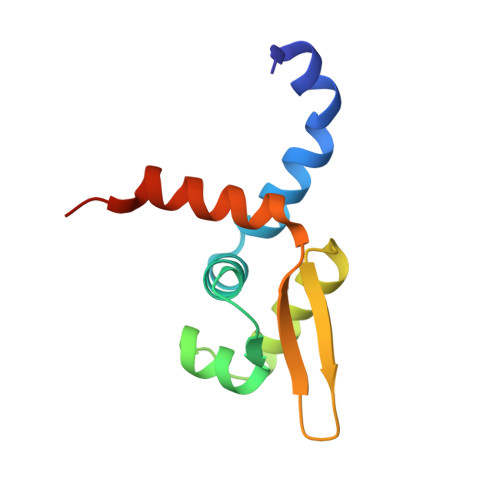Plant Pathogenic Bacteria Utilize Biofilm Growth-associated Repressor (BigR), a Novel Winged-helix Redox Switch, to Control Hydrogen Sulfide Detoxification under Hypoxia.
Guimaraes, B.G., Barbosa, R.L., Soprano, A.S., Campos, B.M., de Souza, T.A., Tonoli, C.C., Leme, A.F., Murakami, M.T., Benedetti, C.E.(2011) J Biol Chem 286: 26148-26157
- PubMed: 21632538
- DOI: https://doi.org/10.1074/jbc.M111.234039
- Primary Citation of Related Structures:
3PQJ, 3PQK - PubMed Abstract:
Winged-helix transcriptional factors play important roles in the control of gene expression in many organisms. In the plant pathogens Xylella fastidiosa and Agrobacterium tumefaciens, the winged-helix protein BigR, a member of the ArsR/SmtB family of metal sensors, regulates transcription of the bigR operon involved in bacterial biofilm growth. Previous studies showed that BigR represses transcription of its own operon through the occupation of the RNA polymerase-binding site; however, the signals that modulate its activity and the biological function of its operon are still poorly understood. Here we show that although BigR is a homodimer similar to metal sensors, it functions as a novel redox switch that derepresses transcription upon oxidation. Crystal structures of reduced and oxidized BigR reveal that formation of a disulfide bridge involving two critical cysteines induces conformational changes in the dimer that remarkably alter the topography of the winged-helix DNA-binding interface, precluding DNA binding. This structural mechanism of DNA association-dissociation is novel among winged-helix factors. Moreover, we demonstrate that the bigR operon is required for hydrogen sulfide detoxification through the action of a sulfur dioxygenase (Blh) and sulfite exporter. As hydrogen sulfide strongly inhibits cytochrome c oxidase, it must be eliminated to allow aerobic growth under low oxygen tension, an environmental condition found in bacterial biofilms, xylem vessels, and root tissues. Accordingly, we show that the bigR operon is critical to sustain bacterial growth under hypoxia. These results suggest that BigR integrates the transcriptional regulation of a sulfur oxidation pathway to an oxidative signal through a thiol-based redox switch.
Organizational Affiliation:
Laboratório Nacional de Biociências, Centro Nacional de Pesquisa em Energia e Materiais, Campinas, São Paulo CP6192, Brazil.














